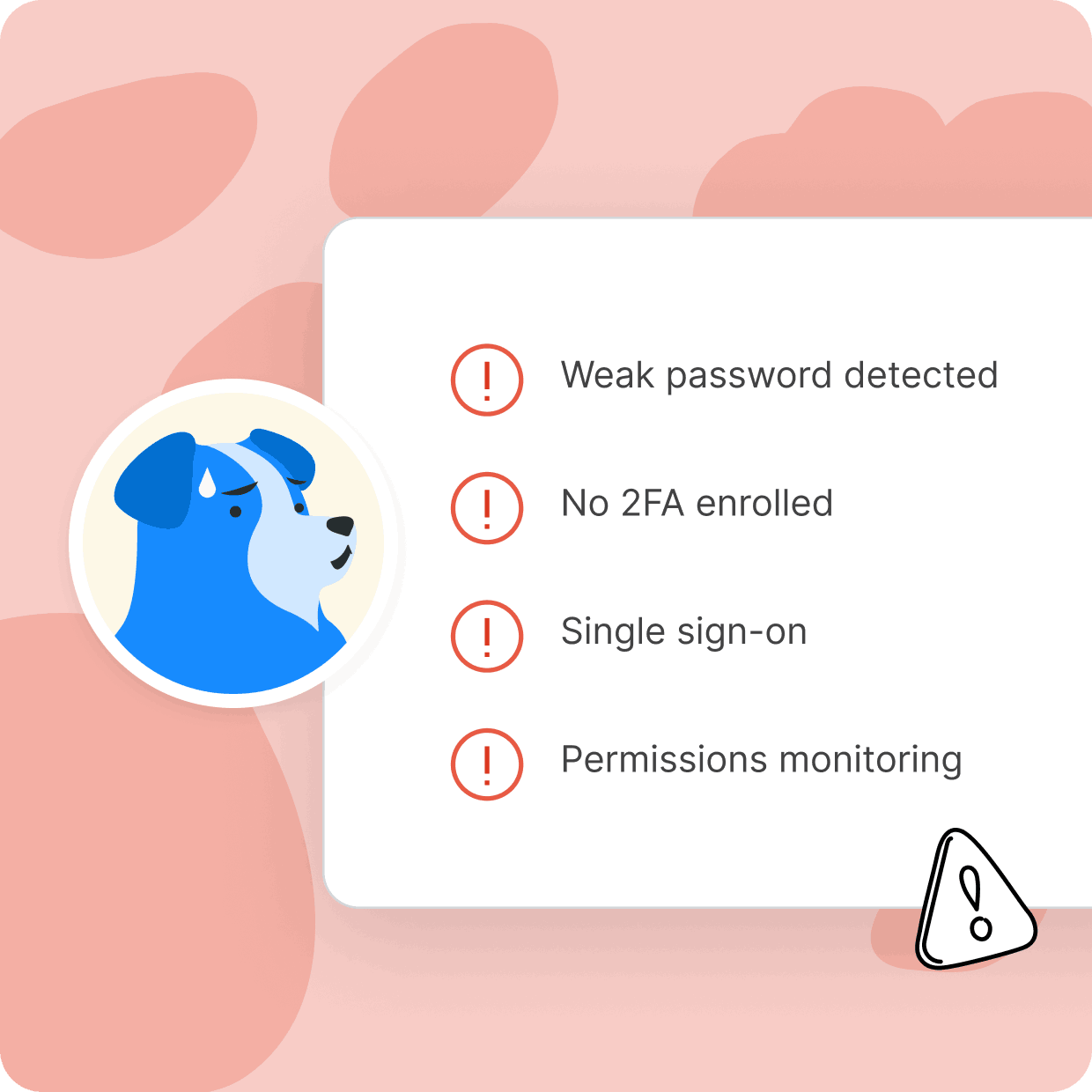Zero trust data security is a security model that assumes all users, devices, and network traffic are untrusted and must be verified before granting access to applications. This approach emphasizes continuous evaluation and verification based on the user's identity, device health, location, and other contextual information, to prevent data breaches and ensure strong protection against cyber threats.
Unfortunately, many applications don't support identity standards like the Security Assertion Markup Language (SAML) and the System for Cross-domain Identity Management (SCIM) specification. Without native support for these standards, applications either can't work with many PAM solutions or require expensive integrations.
Cerby allows you to manage all your SaaS administrator accounts, rotate credentials, and monitor and audit privileged account activities. In this guide, you'll learn about different PAM tools, the challenges, and the players.
Secure Privileged Accounts
Not all accounts are created equal. Some come with administrative permissions that put sensitive data at risk when in the wrong hands. With Cerby, you can help protect your business from bad actors, mistakes, and data breaches.
With Cerby You Can

Secure your SaaS admin accounts

Protect your business from data breaches

Eliminate the costs of custom integrations
Zero Trust Data Security
In today’s cyber threat landscape, zero trust data security has become one of the most popular approaches to safeguarding sensitive data. As cyber-attacks become ever more common and sophisticated, traditional security models are no longer able to keep up with the numerous threats out there. As a result, the concept of zero trust data security has emerged as a more effective strategy to protect against various cyber threats. In this article, we will cover what zero trust data security is, why it’s important, and the basics of how it works.
What Is Zero Trust?
The zero trust model refers to a type of security model based on the principle of maintaining strict access controls and a high level of security throughout an organization’s digital infrastructure. This model assumes that all devices and users on a network – even those inside the organization – are potential threats. Or in other words, the zero trust principle could be phrased as “never trust, and always verify.”
The zero trust security model is a departure from more traditional, perimeter-based security models that assume everything within the organization’s network can be trusted. In a true zero trust model, every user, every device, and every application is subject to verification before being granted access to sensitive data. This means that every request to access data or privileged resources must be authenticated, authorized, and encrypted before access is granted. However, organizations are not able to reduce the cybersecurity risks caused by shared accounts, according to the Ponemon Institute study. This becomes especially difficult with nonfederated applications, as it's said that less than half, 41%, of respondents actually have a process to make nonfederated applications secure and compliant with their organization’s policies.
What Is Zero Trust Security?
Zero trust security operates on the basic principle of least privilege, which means that users and devices are given access only to the minimum amount of data and resources necessary to perform required functions. This draconian approach reduces the attack surface and limits the potential damage a cybercriminal can wreak if they manage to breach the network.
By assuming that no device, user, or application can be trusted, zero trust security measures significantly reduce the risk of data breaches and protect against insider threats and other nefarious cybercrime activity.
Zero Trust Architecture
Essentially, zero trust architecture is based on a set of principles known as the “7 pillars of zero trust” which comprise the foundations of zero trust frameworks. These seven pillars include:
- Device identification and authentication
- User identification and authentication
- Authorization and access control
- Data protection
- Network segmentation
- Logging and monitoring
- Incident responses
In tandem, these zero trust pillars work together to create a multi-layered security approach that can protect against internal and external threats alike.
One of the most critical elements of zero trust architecture is the framework. A zero trust framework can provide guidelines and best practices for implementing zero trust principles within an organization’s IT infrastructure. Zero trust frameworks can also be designed to be flexible and adaptable, allowing businesses or organizations to customize their security strategy to address their specific needs or requirements.
Another vital component of zero trust architecture is the zero trust NIST (National Institute of Standards and Technology) framework. The NIST framework gives organizations a detailed set of guidelines and standards for implementing zero trust principles within an organization. This framework is based on continuous monitoring and improvement, which means that organizations must continually evaluate and update their security measures to ensure that they remain effective against the latest cyber threats.
In contrast to more traditional security models, which usually rely on perimeter-based security and assume that all devices and users within the network can be trusted, the zero trust architecture assumes that all devices, users, and applications are untrustworthy and must be verified and authenticated before being granted access to sensitive information. This approach is specially engineered to provide more stringent data protection by minimizing the attack surface and significantly reducing the risk of data breaches.
How To Implement Zero Trust
Implementing zero trust data security is a great way for organizations to bolster their security posture. With the proper approach, zero security implementation can be a valuable investment in an organization’s security and longevity. Here’s a step-by-step guide on how to implement zero trust data security:
Step 1: Evaluate your existing security posture
The first step in implementing zero trust measures is to assess your organization’s present security posture. This may involve identifying and inventorying your assets, data flows, and any potential vulnerabilities.
Step 2: Establish a zero trust architecture NIST framework
The NIST framework provides a structured approach to setting up zero trust security, and by following their framework, you can create a comprehensive security plan that covers every aspect of your company’s security needs.
Step 3: Implement zero trust identity and access management
Identity and access management (IAM) is a major component of zero trust security measures. This typically involves verifying the identity of users and devices before allowing access to sensitive data or systems.
Step 4: Apply network segmentation
Network segmentation essentially means dividing up your internal network into smaller, more secure segments. This reduces the attack surface and decreases cybercriminals’ ability to move laterally through your network.
Step 5: Use multi-factor authentication
Multi-factor authentication (MFA) provides an added layer of security by requiring users to provide more than one form of authentication in order to access sensitive data.
Step 6: Encrypt your data
Encryption is necessary to protect your data from unauthorized access. Encrypting your data ensures that even if the information is intercepted, it will be unreadable without the decryption key.
Step 7: Continuously monitor your environment
Zero trust security necessitates constant surveillance. You can quickly detect and respond to any potential threats by continuously monitoring your IT environment.
Tools like Zero Trust AWS can also help companies implement zero trust security measures. AWS provides numerous security services that can help facilitate organizations’ implementation of zero trust security.
Zero Trust Data Protection
Zero trust data protection has become practically essential for modern organizations to protect their sensitive data from various cyber threats. And because of this, there are now numerous zero trust solutions available in the market that can provide assistance to organizations seeking to implement this security model effectively.
Zero trust vendors like Cloudflare, Okta, Microsoft, and Google provide copious zero trust solutions enabling organizations to secure their data. Cloudflare’s Zero Trust solution, for instance, gives organizations the ability to secure access to applications and data without relying on traditional VPNs. Zero Trust Cloudflare’s global network provides secure access to applications, regardless of their location.
Cerby is another zero trust data protection solution that has recently become one of the leading solutions in the market thanks to its focus on simplifying role-based access control (RBAC) policy management and enforcing zero trust cyber security principles. RBAC is a vital component of zero trust security that involves granting users the bare minimum access required to perform a certain action. Cerby’s platform enables organizations to automate the creation and management of RBAC policies, streamlining the process of implementing zero trust principles.
Cerby’s platform also integrates with other popular identity providers like Okta and Microsoft Azure AD, allowing organizations to leverage their current identity management infrastructures. This integration also helps by simplifying the implementation of zero trust security measures and generally ensures that RBAC policies are enforced consistently throughout the organization.
Zero trust vendors like Cloudflare, Okta, Microsoft, and Google can provide comprehensive solutions that empower businesses to secure their sensitive data. Cerby’s platform, with its focus on RBAC policy management, provides a unique advantage that can simplify the implementation of zero trust security measures.
Zero Trust Architecture Example
Zero trust architecture has become more popular in recent years as more organizations seek to adopt zero trust security models to enhance their cyber-security postures. Some examples of organizations that have successfully adopted zero trust architecture include Microsoft, Google, Cisco, and others.
Microsoft is one of the most well-known examples of a company that has had great success in implementing its zero trust architecture. Microsoft’s implementation process involved creating a zero trust policy that focus on minimizing their attack surface by enforcing strict access control measures. Microsoft's zero trust policy builds on its zero trust reference architecture, which provides the basic framework for implementing zero trust security initiatives.
As a result of implementing zero trust architecture, Microsoft enjoys the benefits of improved visibility into network traffic, enhanced data protection measures, and an overhauled security posture. The company’s zero trust policy has helped to reduce the risk of cyber threats by enforcing numerous access control policies and significantly reducing the attack surface.
Google is another organization that’s achieved relative success in adopting zero trust architecture. Google’s implementation process involved segmenting its network and devising a set of access controls to enforce the principle of least privilege. Google also implemented multi-factor authentication and robust encryption protocols to protect sensitive data.
Several organizations – including two of the world’s leading digital enterprises, Microsoft and Google – have successfully implemented zero trust architecture to enhance their cyber security posture. These organizations have shown that their zero trust policies can enforce strict access control policies, multi-factor authentication, as well as network segmentation to minimize the attack surface and reduce the overall risk of cyber threats.
